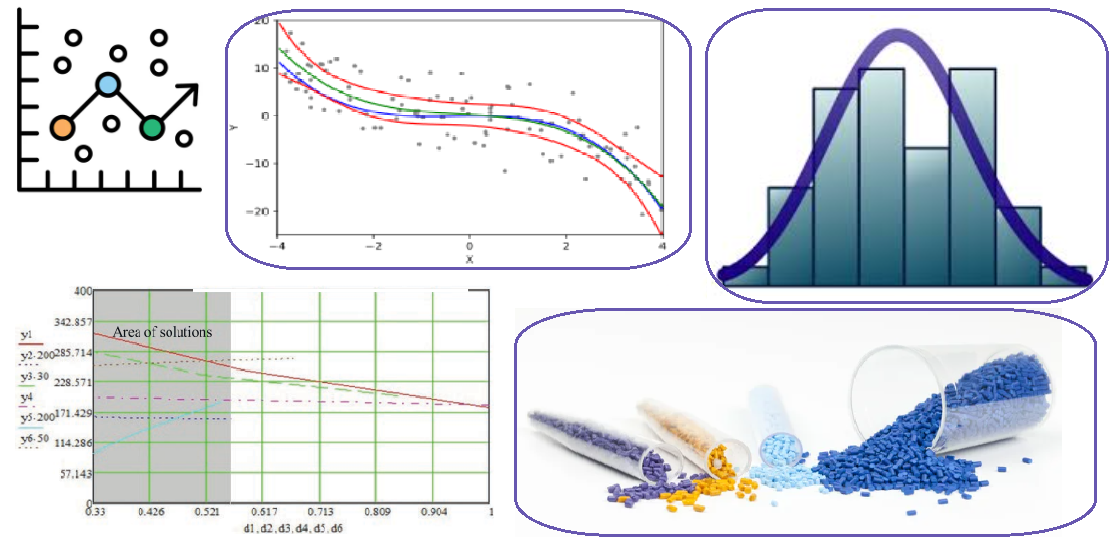Пошук оптимального рішення у фармацевтичних технологічних дослідженнях з кількісними факторами із застосуванням статистичних методів
DOI:
https://doi.org/10.15587/2519-4852.2024.313819Ключові слова:
статистичний метод, регресійний аналіз, багатокритеріальна оптимізація, критерій оптимізації, фармако-технологічний показникАнотація
Мета. Розробка методичного підходу до визначення оптимального рішення з використанням статистичних методів у фармако-технологічних дослідженнях з кількісними факторами на прикладі встановлення оптимального вмісту наповнювача у твердій дисперсії при виготовленні гранул.
Матеріали та методи. Методика пошуку оптимального рішення показана на прикладі розробки гранул, до складу яких входить тверда дисперсія кверцетину з поліетиленоксидом 6000. Для встановлення оптимальної кількості наповнювача застосований метод математичного моделювання із використанням методів статистичного аналізу та багатокритеріальної оптимізації. Для обробки експериментальних даних та проведення розрахунків були задіяні такі програмні засоби, як електронні таблиці MS Excel та Mathcad 14.
Результати. Формалізацію задачі надано у придатному для вирішення експериментально-статистичними методами вигляді. Розглянуто питання побудови математичних моделей у вигляді регресійних рівнянь, що характеризують вплив кількісного вмісту наповнювача на низку фармако-технологічних показників гранул за експериментальними даними. Акцентовано увагу на особливості застосування статичних методів для обробки експериментальних даних у фармацевтичних дослідженнях, а саме на встановлення структури рівнянь регресії та оцінювання їх адекватності. Запропоновано критерій багатокритеріальної оптимізації, який формується на підставі отриманих рівнянь регресії з урахуванням введених обмежень за кожним окремим критерієм.
Висновки. Апробовано методичний підхід до визначення оптимального рішення у фармацевтичних технологічних дослідженнях з кількісними факторами із застосуванням експериментально-статистичних методів та теорії багатокритеріальної оптимізації на прикладі встановлення оптимального вмісту наповнювача у твердій дисперсії при виготовленні гранул. Визначено оптимальне співвідношення наповнювача до твердої дисперсії, яке забезпечує максимальне наближення всіх досліджуваних фармако-технологічних показників гранул у рівному ступені до їх оптимальних значень. Жоден із показників не виходить за встановлені дослідником межі й має мінімально можливе погіршення відносно індивідуально визначеного оптимуму
Посилання
- Chatterjee, S., Moore, C. M. V., Nasr, M. M. (2017). Overview of the Role of Mathematical Models in Implementation of Quality by Design Paradigm for Drug Development and Manufacture. Food and Drug Administration Papers. 23. http://digitalcommons.unl.edu/usfda/23
- Piri, Mohsen. (2023). Review of Regression Algorithms. Available at: https://www.researchgate.net/publication/373514743_Review_of_Regression_Algorithms
- Lapach, S. N., Pasichnyk, M. F., Chubenko, A. V. (1999). Statystychni metody v farmakolohii i marketynhu farmatsevtychnoho rynku. Kyiv, 312.
- Frasser, C. (2006). Mathematical methods of experimental data processing and analysis (Or Methods of Curve Fitting). Available at: https://www.researchgate.net/publication/319256581
- Mahbobi, M., Tiemann, T. K. (2015). Introductory Business Statistics with Interactive Spreadsheets. Victoria: BCcampus. Available at: https://opentextbc.ca/introductorybusinessstatistics/
- Henderson, H. V., Velleman, P. F. (1981). Building Multiple Regression Models Interactively. Biometrics, 37 (2), 391–411. https://doi.org/10.2307/2530428
- Odu, G. O. (2013). Review of Multi-criteria Optimization Methods – Theory and Applications. IOSR Journal of Engineering, 3 (10), 1–14. https://doi.org/10.9790/3021-031020114
- Hroshovyi, T. A., Martseniuk, V. P., Kucherenko, L. Y., Vronska, L. V., Hyrieieva, S. M. (2008). Matematychne planuvannia eksperymentu pry provedenyy naukovykh doslidzhen v farmatsii. Ternopil: Ukrmedknyha, 377
- Tanavalee, C., Luksanapruksa, P., Singhatanadgige, W. (2016). Limitations of Using Microsoft Excel Version 2016 (MS Excel 2016) for Statistical Analysis for Medical Research. Clinical Spine Surgery: A Spine Publication, 29 (5), 203–204. https://doi.org/10.1097/bsd.0000000000000382
- Herzog, M. H., Francis, G., Clarke, A. (2019). Understanding Statistics and Experimental Design. Springer Cham, 142. https://doi.org/10.1007/978-3-030-03499-3
- Derzhavna Farmakopeia Ukrainy. Vol. 1 (2015). Kharkiv: Derzhavne pidpryiemstvo «Ukrainskyi naukovyi farmakopeinyi tsentr yakosti likarskykh zasobiv», 1128.
- Divisi, D., Di Leonardo, G., Zaccagna, G., Crisci, R. (2017). Basic statistics with Microsoft Excel: a review. Journal of Thoracic Disease, 9 (6), 1734–1740. https://doi.org/10.21037/jtd.2017.05.81
- Kundrat, A. M., Kundrat, M. M. (2014). Naukovo-tekhnichni obchyslennia zasobamy Mathcad ta MS Excel. Rivne: NUVHP, 252.
- Kovalevska, I., Ruban, O., Kutova, O., Levachkova, J. (2021). Optimization of the composition of solid dispersion of quercetin. Current Issues in Pharmacy and Medical Sciences, 34 (1), 1–4. https://doi.org/10.2478/cipms-2021-0001
- Lapach, S. N. (2016). Rehressyonnii analyz. Protsessnii podkhod. Matematychni mashyny i systemy, 1, 125–133.
- Yamuna, M., Elakkiya, A. (2017). Mathematical Models in Drug Discovery, Development and Treatment of Various Diseases-A Case Study. Research Journal of Pharmacy and Technology, 10 (12), 4397-4401. https://doi.org/10.5958/0974-360x.2017.00810.1
- Hogg, R. V., McKean, J. W., Craig, A. T. (2019). Introduction to mathematical statistics. Boston: Pearson, 762.
- Salukvadze, M. E. (1979). Vector-valued optimization problems in control theory. Vol. 148 (Mathematics in Science and Engineering). Academic Press, 219.
- Pascoletti, A., Serafini, P. (1984). Scalarizing vector optimization problems. Journal of Optimization Theory and Applications, 42 (4), 499–524. https://doi.org/10.1007/bf00934564
- Kutova, O. V., Sahaidak-Nikitiuk, R. V. (2023). A methodical approach to the multi-criteria selection in the pharmaceutical technological research with quantitative factors. News of Pharmacy, 105 (1), 38–43. https://doi.org/10.24959/nphj.23.105
- Lapach, S. N., Radchenko, S. H., Babych, P. N. (1993). Planyrovanye, rehressyia y analyz modelei PRIAM (PRYAM). Kyiv, 24–27.

##submission.downloads##
Опубліковано
Як цитувати
Номер
Розділ
Ліцензія
Авторське право (c) 2024 Olga Kutova, Rita Sahaidak-Nikitiuk, Inna Kovalevska, Nataliya Demchenko

Ця робота ліцензується відповідно до Creative Commons Attribution 4.0 International License.
Наше видання використовує положення про авторські права Creative Commons CC BY для журналів відкритого доступу.








